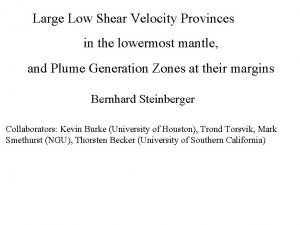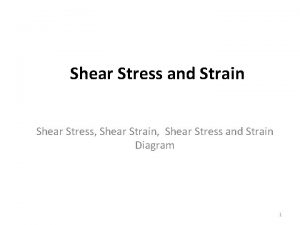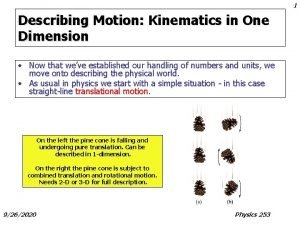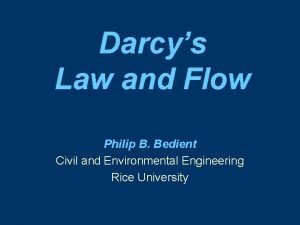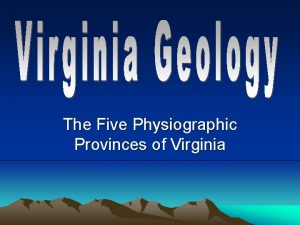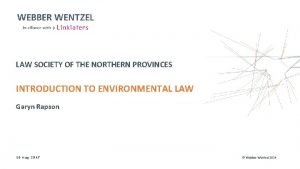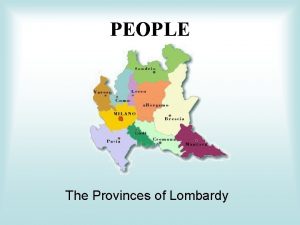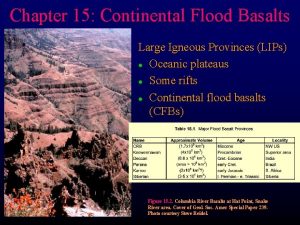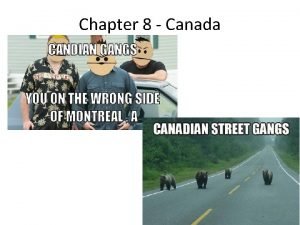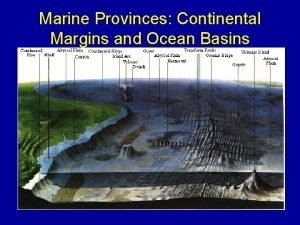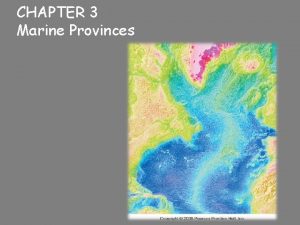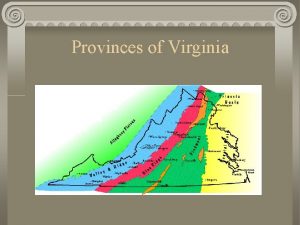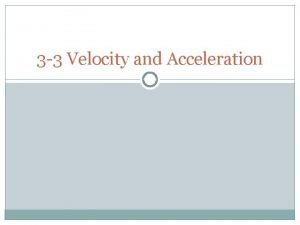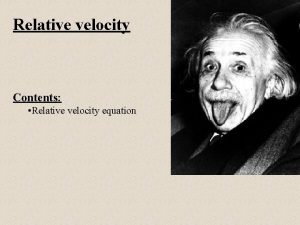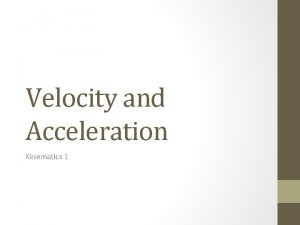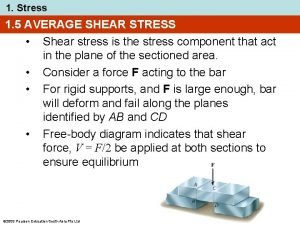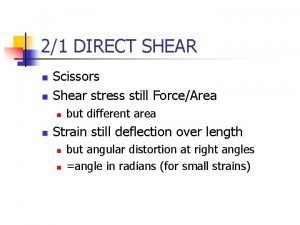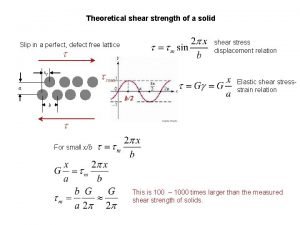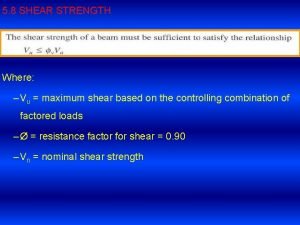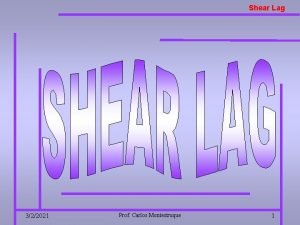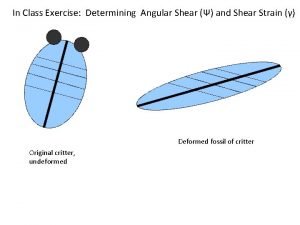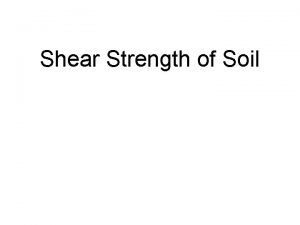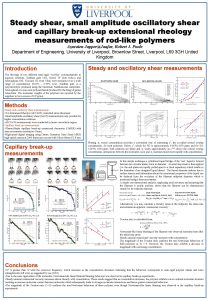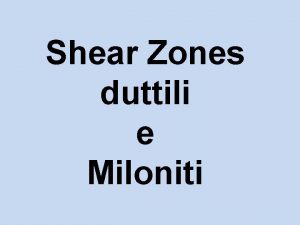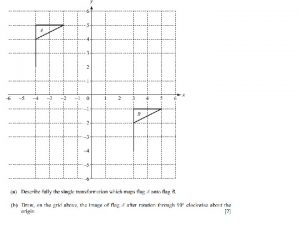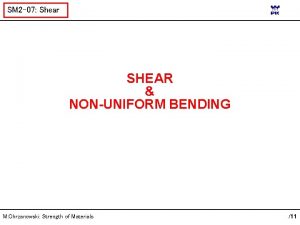Large Low Shear Velocity Provinces in the lowermost






























- Slides: 30

Large Low Shear Velocity Provinces in the lowermost mantle, and Plume Generation Zones at their margins Bernhard Steinberger Collaborators: Kevin Burke (University of Houston), Trond Torsvik, Mark Smethurst (NGU), Thorsten Becker (University of Southern California)

Where do mantle plumes originate from? Is there a chemically distinct reservoir in the mantle, and if so, where and how large is it?


Richards, Duncan, Courtillot (1989): Flood basalts and hotspot tracks: Plume heads and tails

Montelli et al. (2006) Mantle tomography beneath Hawaii


Large Igneous Provinces (LIPs) could be more representative of deep mantle plumes

Reconstructed LIP eruption sites (circles) and hotspots (crosses) plotted on smean tomography model in lowermost mantle. Blobs with other color scale for steep gradients Plume heads from the edges (-1% contour) of Large Low Shear Velocity Provinces (LLSVPs) Steep gradients along the same contour

Masters et al. (2000) Anti-correlation of shear wave velocity and bulk sound velocity vc=(Ks/ )1/2 in lowermost mantle

Density anomaly (degrees 2, 4, 6) determined directly using normal modes (Ishii and Tromp, 2004)

Wang and Wen (2004) VLVP (Very Low Velocity Province) has rapidly varying thicknesses from 300 to 0 km, steeply dipping edges. . . structural and velocity features unambiguously indicate that the VLVP is compositionally distinct. ”

Further evidence (more quantitative) that those proposed chemically distinct bodies actually exist for what they look like that the coincidence of reconstructed LIPs and LLSVP boundaries is extremely unlikely to result by pure chance

Bimodal distribution


Frequency distribution of seismic velocity smean model (Becker and Boschi, 2002) Depth 2799 km (91 km above CMB)

Frequency distribution of seismic velocity smean model (continuous lines) Castle et al. (2000) (dotted) Kuo et al. (2000) (dashed)

1 % contours of smean tomography model contours of chemically distinct piles?


Reconstructed LIPs and hotspots with Kuo et al. (2000) D'' model

Reconstructed LIPs and hotspots with Castle et al. (2000) D'' model GILL JASON DON TUZO

Scoresheet TUZO (African) JASON (Pacific) total 8. 4 (6. 2)· 109 km 3 5. 8 (5. 3)· 109 km 3 14. 2· 109 km 3 (4. 9· 109 km 3 Wang and Wen, 2004) % of mantle 0. 94% (0. 69%) 0. 65% (0. 59%) 1. 59% Volume Mass 4. 5 (3. 4)· 1022 kg % of mantle 1. 13% (0. 84%) 3. 1 (2. 9)· 1022 kg 7. 7· 1022 kg 0. 79% (0. 73%) 1. 91% Area on CMB 1. 6· 107 km 2 (1. 8· 107 km 2 Wang and Wen, 2004) % of CMB 10. 2% 10. 6% Max. height ~1800 (600) km 3. 2· 107 km 2 20. 9% ~1400 (600) km “Center of mass” (latitude, longitude, ave. elevation above CMB) bottom layer 17. 0°S 13. 6°E 11. 4°S 164. 3°W bottom 4 ~s 15. 7°S 12. 0°E 229 km 10. 9°S 162. 4°W 192 km 211 km total 15. 6°S 13. 0°E 409 km 11. 0°S 162. 9°W 239 km 339 km

Reconstructed LIPs (here: global moving hotspot reference frame) close to +13 m contour of geoid Similar shape of LLSVPs and geoid highs away from subduction zones

Correlation of LIPs (paleomagnetic frame) with tomography (thick lines) and gradients Calculations done by Thorsten Becker

Belts with 5° half width on either side of -0. 96% contour occupy 23. 5% of CMB 18 out of 24 reconstructed LIPs within belts Probability for 18 out of 24 or more randomly chosen points to lie within 23. 5% area is ~1/7, 000

Probability for number of LIPs found within a certain distance of LLSVP/LSVP margins or higher number to occur for random points Dashed lines: In situ LIPs Continuous lines: reconstructed LIPs (paleomagnetic reference frame) LLSVP/LSVP margins inferred from smean lowermost layer Castle et al. (2000) Kuo et al. (2000)

Correspondence between top and base of mantle: Continents oceanic lithosphere subducted slabs LLSVPs D'' material between LLSVPs mantle plumes negatively buoyant positively buoyant sinking rising cooling down heating up surface subduction zones CMB "Plume Generation Zones"

Plate tectonics: Dynamics of D'': Oceanic lithosphere cools down at the surface and gradually becomes negatively buoyant. It moves towards subduction zones, mostly at the edges of chemically distinct and positively buoyant continents, where it sinks back into the mantle, in the form of subducted slabs. D'' material outside LLSVPs heats up at the CMB and gradually becomes positively buoyant. It moves towards “Plume generation zones”, mostly at the edges of chemically distinct and negatively buoyant LLSVPs, where it rises back into the mantle, in the form of mantle plumes.

Q: Where do mantle plumes originate from? Q: Is there a chemically distinct reservoir in the mantle, and if so, where and how large is it?

Q: Where do mantle plumes originate from? A: From the lowermost mantle (at least those causing LIP eruptions), more specifically from the Plume Generation Zones at the edges of Large Low Shear Velocity Provinces (LLSVPs) Q: Is there a chemically distinct reservoir in the mantle, and if so, where and how large is it?

Q: Where do mantle plumes originate from? A: From the lowermost mantle (at least those causing LIP eruptions), more specifically from the Plume Generation Zones at the edges of Large Low Shear Velocity Provinces (LLSVPs) Q: Is there a chemically distinct reservoir in the mantle, and if so, where and how large is it? A: Yes, the African and Pacific LLSVPs. Each of them contains about 1 % of mantle mass.
 Large low shear velocity provinces
Large low shear velocity provinces Specific weight unit
Specific weight unit Shear strains
Shear strains Is v final velocity
Is v final velocity Rotational motion and the law of gravity
Rotational motion and the law of gravity Darcy velocity vs seepage velocity
Darcy velocity vs seepage velocity Speed unit
Speed unit Angular acceleration formula in terms of radius
Angular acceleration formula in terms of radius Difference between linear and angular acceleration
Difference between linear and angular acceleration Instantaneous velocity vs average velocity
Instantaneous velocity vs average velocity Initial velocity and final velocity formula
Initial velocity and final velocity formula Derivation of darcy's law
Derivation of darcy's law Low velocity impact spatter
Low velocity impact spatter Significant figures
Significant figures Supportive communication style
Supportive communication style Low voltage hazards
Low voltage hazards Mid low high
Mid low high The young man from the provinces archetype examples
The young man from the provinces archetype examples Physiographic provinces of virginia
Physiographic provinces of virginia Why does the moon anger the sun tinguian folktale
Why does the moon anger the sun tinguian folktale Law society of the northern provinces
Law society of the northern provinces English speaking provinces in canada
English speaking provinces in canada Provinces in lombardy
Provinces in lombardy North canada provinces
North canada provinces Kappa psi provinces
Kappa psi provinces Flood basalt provinces diagram
Flood basalt provinces diagram Largest of the three prairie provinces
Largest of the three prairie provinces Heaven vs hell archetype examples
Heaven vs hell archetype examples Passive and active continental margins
Passive and active continental margins Precision depth recorder
Precision depth recorder Garden archetype in harry potter
Garden archetype in harry potter
